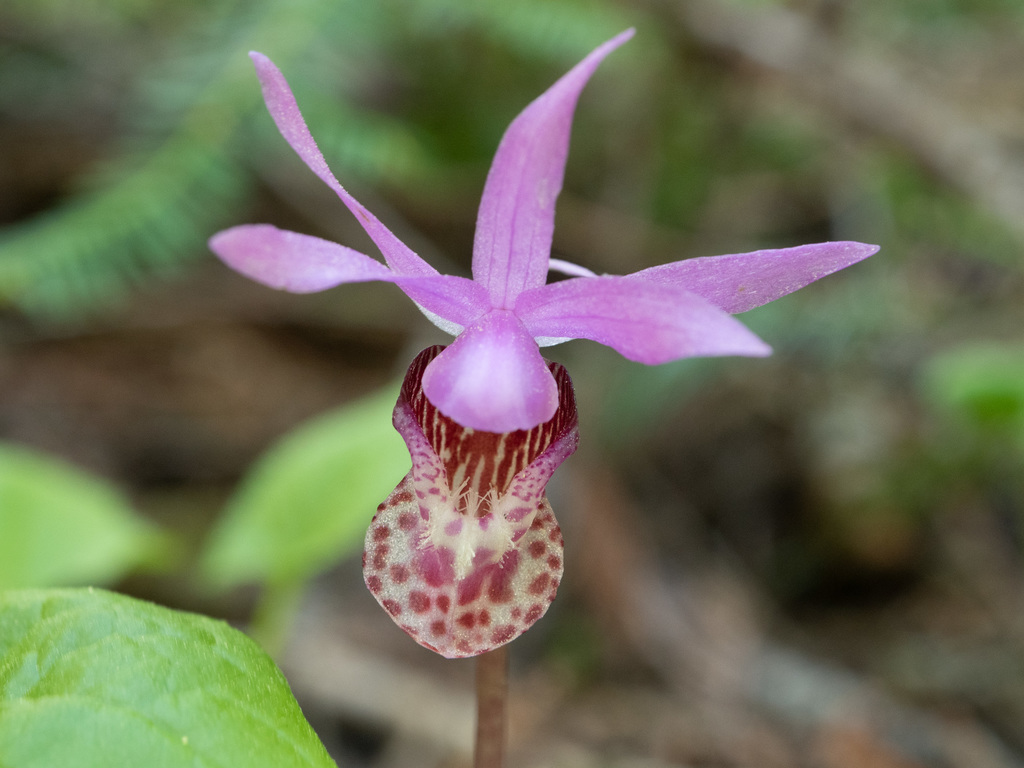Varieties of Calypso bulbosa in North America
Calypso bulbosa was described in 1842 by William Oakes (it was previously described by Linnaeus as Cypripedium bulbosum). It grows a single leaf in the fall which persists through winter and then withers away just after flowering in late spring. In the spring it produces a single, (or very rarely two) pink (or rarely white) slipper-shaped flower. Surprisingly, it is not related to other slipper orchids but is instead a close relative of orchids such as Corallorhiza, Tipularia, and Aplectrum. The species is distributed throughout North America, as well as much of Europe and Asia. In North America there are two varieties and one hybrid variety of Calypso bulbosa, C. bulbosa var. americana, C. bulbosa var. occidentalis and C. bulbosa nothovar. kostiukiae (a naturally occurring hybrid between the previous varieties). Luckily, The varieties are actually quite easy to identify once you know what to look for.
Calypso bulbosa var. occidentalis:
This variety is found (as its name suggests) mostly on the west side of North America (a plant I found near my home in Bozeman, MT is the most easterly observation on iNaturalist to date). It has numerous maroon spots on the lamina (the blade like top of the labellum) and the “beard” (likely false anthers to attract bees) is white (or very pale pink) and sparse. Another (though rather redundant) method of identifying this variation is by the lamina, it is usually slightly shorter than the horns (likely false nectar spurs) whereas in C. bulbosa var. americana the lamina is about the same length or a little longer.

Calypso bulbosa var. occidentalis showing off its numerous spots and lack of a yellow “beard”
Calypso bulbosa var. americana:
This variety has a much larger range than C. bulbosa var. occidentalis, it can be found from the east coast of the United States and Canada to Alaska and south to Arizona and New Mexico. It has a thick yellow beard and no significant spots on the labellum (there are actually usually about four spots nestled in the beard).

Calypso bulbosa var. americana Note the yellow “beard” and absence of maroon spots on the labellum.
Calypso bulbosa nothovar. kostiukiae:
Found anywhere the ranges of C. bulbosa var. americana and C. bulbosa var. occidentalis overlap. It has both a thick yellow “beard” and many spots on the labellum. This is probably my favorite variety of Calypso bulbosa not only because it looks nice but also because it is one of the few naturally occurring hybrids in Montana.

Calypso bulbosa nothovar. kostiukiae showing distinctive combination of spots and a yellow “beard”.
That other variation (form?):
I have seen this odd form on two separate occasions, it has neither spots or a yellow beard. My first instinct was to think it was an aberrant flower, but one of the plants has bloomed the same way two years in a row (I only found the other one last year so I have yet to see it bloom a second time). My best guess is that it is either a spotless form of C. bulbosa var. occidentalis (or a beardless form of var. americana?) or a double recessive C. bulbosa nothovar. kostiukiae. Both plants were found near C. bulbosa nothovar. kostiukiae.

An unidentified variety of Calypso bulbosa after consulting @juancerda and @arethusa, I am fairly confident this is C. bulbosa var. americana.
Hopefully you have found this helpful or at least entertaining,
happy orchid hunting!
觀察
觀察者
afid描述
A group of Calypso bulbosa nothovar. kostiukiae (C. bulbosa var. occidentalis x C. bulbosa var. americana) showing characteristic spots and yellow beard.
觀察者
afid描述
An unusual form of calypso bulbosa. I suspect this might be a double recessive form of C. bulbosa var. kostiukiae that is lacking both spots and yellow fuzz.









評論
Nice!
Great!
Thanks! I enjoyed writing it!
This is very helpful - very clear identification of what to look for, and really good pix showing them. Thanks much!
Spectacular! I really enjoyed this. :)
Very nice—quite informative with beautiful photography.
Thanks everyone!!
Great article @afid!. WIth respect to the white lipped C. bulbosa. It is most likely a mutant C. bulbosa americana that just happens to have lost the yellow pigmentation. I have seen some images of plants similar to yours in areas where var occidentalis is not found. Here are two links with observations that also include Calypso lacking yellow pigmentation.
https://www.flickr.com/photos/ab_orchid/15008923179
http://www.plantsinusa.com/show/plant/Fairy-Slipper/15653
One thing I should clarify is that C. bulbosa americana does have a few spots scattered in the "bearded" area but not the lip blade which is why you are able to identify this white lip mutant as var. americana. X kostiukiae will show more porminent spots on the lip blade.
Amazing article, very informative article and the images are just breathtaking!
Thanks @juancerda I couldn't find any information on the odd variety so I really appreciate your insight!
Excellent article and great find of what I agree is an aberrant form of v. americana. Thanks for the message on my blog. I joined iNaturalist some years ago but never did anything on it.
Thanks @ronaldhanko
Very helpful.
I can see why Calypso bulbosa nothovar. kostiukiae is a favorite. Beautiful.
新增評論